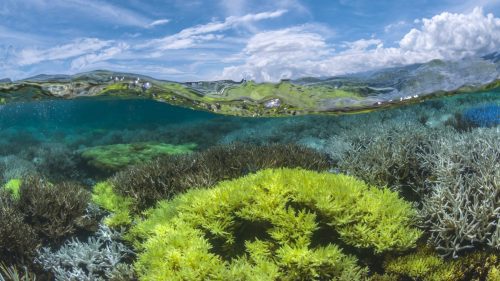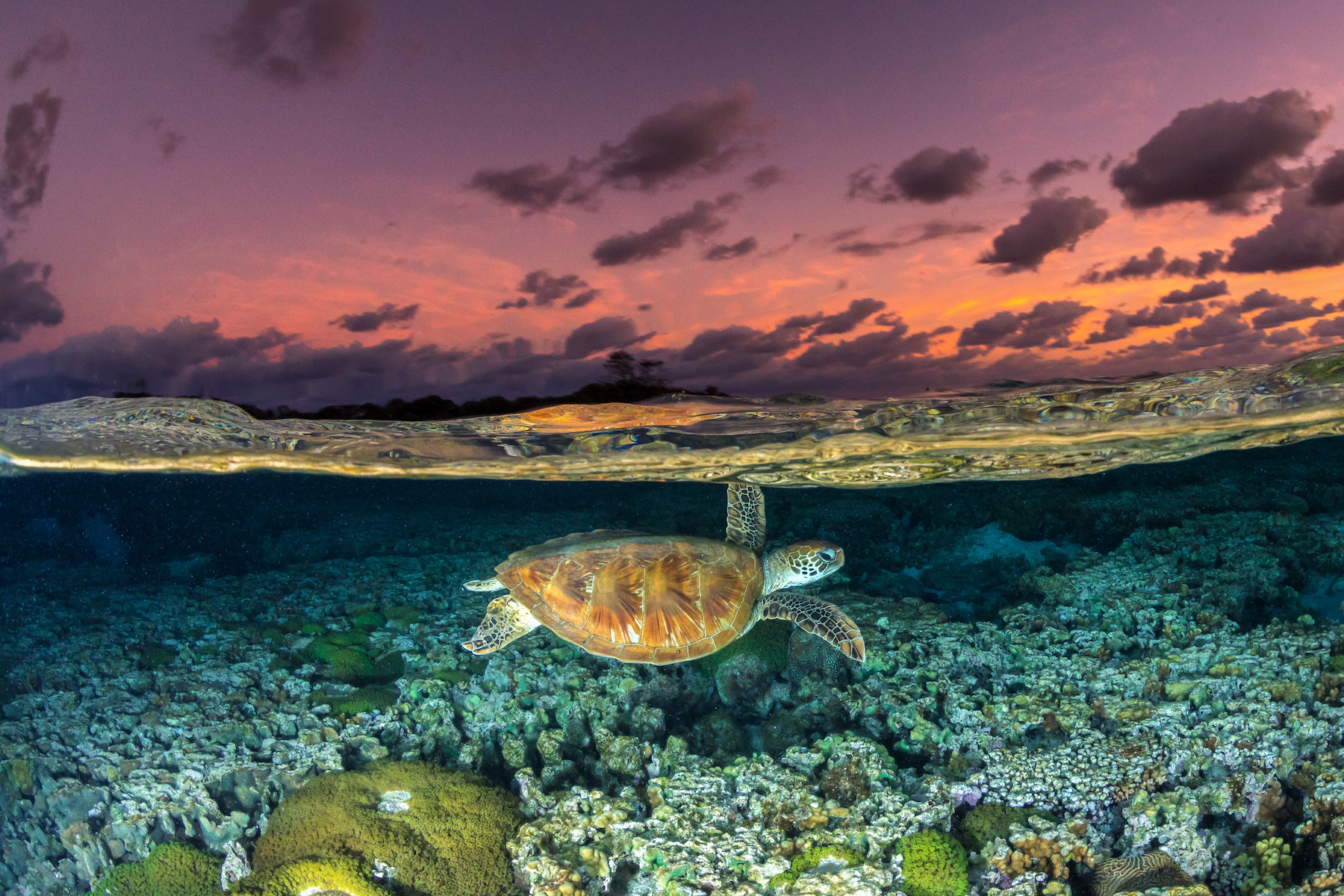How does the ocean affect the climate?

What we know as the Pacific, Atlantic, Indian, Arctic, and Southern Ocean basins represent one connected body of saltwater, also called the Global Ocean, which covers about 71% of the surface of the planet. In its vastness and depth, it contains 321,003,271 cubic miles* of water, that is 97% of all the water found on our planet.
Knowing this, it is perfectly understandable that its balance and health is essential for all life on Earth, and that the ocean has a huge influence on the weather and climate both on a local and a global scale.
In this article, we will explore the two-way relationship that links one of the main issues of our time, climate change, with the Earth’s ocean and its dynamics.
The Ocean and Global Climate Regulation
As we mentioned above, the ocean is the biggest ecosystem on Earth, and it plays a central role in climate regulation globally. By absorbing heat from the atmosphere and moving it around the planet with water currents, it helps to maintain an essential balance: warmer currents move from the Equator towards the Poles, where they cool and circle back, affecting the planet’s weather patterns, regulating seasons, rainfall, droughts, and floods.
In fact, more than 90% of excess heat due to climate change has ended up in the sea.
The Ocean is also the world’s largest carbon sink, which means it absorbs and stores carbon dioxide as part of the carbon cycle: an estimated 83% of the global carbon cycle is carried out through marine waters.
Without the ocean absorbing heat and greenhouse gases, temperatures would be rising at a much faster rate.
How has the ocean changed over time?
As we’ve seen, the ocean plays an essential role in balancing the climate. However, the massive amount of carbon dioxide and other gases humans have been pumping into the atmosphere, with the subsequent rise in temperatures, is more than our ocean can handle.
In the past decades, the relationship between these two natural forces has been altering, and the global consequences are intensifying as time goes by.
In the past 200 years, it is estimated that the ocean has absorbed up to one-third of the carbon dioxide produced by human activities, and up 90% of the extra heat trapped in the atmosphere by the rising concentration of greenhouse gases.
Climate change is the consequence of decades of increasing carbon emissions, and the extra gas and heat are slowly building up in the ocean, altering its balance and that of the whole planet.
Ocean indicators of Climate Change
One of the greatest concerns scientists have regarding climate change and the ocean is that the basic chemistry of the ocean has been changing faster than it ever has over the past 65 million years, affecting marine wildlife, human society, and global weather patterns.
Temperature
One of the main consequences of climate change is the rising water temperatures in the ocean. During the 20th Century, ocean surface temperatures increased around the world. Even considering year-to-year variations, the overall increase is clear. Moreover, surface temperatures have been consistently higher over the past three decades than at any other time since the late 1800s, when reliable observation began.
Rising sea temperatures cause a phenomenon known as “coral bleaching”, the sudden death of large parts of coral reefs; this happens because, when the water is too warm, the corals expel the algae living in their tissues, consequently turning white. According to recent research, coral might be able to recover from bleaching, but it remains permanently weakened.
The rise in ocean temperatures also causes the world’s polar ice sheets and glaciers to melt, adding freshwater to the sea. This changes the chemical composition of the ocean water, making it hard for some species to survive.
The excess freshwater also changes ocean currents, which are governed by saltwater and heat, and if these change occur, even if slightly, they alter the nutrients present in the ocean, which often leads to oxygen-depleted “dead zones”, where marine life cannot survive.
Due to dead zones and warmer habitats, local climate might change, and many wildlife species shift to cooler waters, which in turn has an impact on human communities that rely on those fish for food.

Sea level
When ice sheets and glaciers on land melt, they add water volume to the ocean, which causes the rise of sea levels globally. This is a serious threat to low-lying land and important coastal environments, such as mangrove forests and wetlands, as they may become inundated and destroyed.
Sea level has been rising globally at a rate of roughly six-tenths of an inch per decade since 1880. In recent years, this rate has accelerated even more, reaching more than one inch per decade.
The Intergovernmental Panel on Climate Change (IPCC) states that, by 2100, the level of the sea will be 0.26 meters to 0.77 meters higher than it is at the moment. It is estimated in the next half-century, rising sea level will be one of the main threats humans will face, putting the life of 200 million people who live in low-lying coastal areas at risk.
Coastal flooding
With the increase of sea level, dry land and wetlands can turn into open water. This problem is worsened, along many parts of the Atlantic coast, by low elevations and sinking land.
Flooding is becoming more and more frequent with the rise in sea level in the U.S.: it has already been recorded that, between the years of 1996 and 2011, the coastline from Florida to New York lost more land than it gained.
Also, every site measured has seen an increase in coastal flooding since the 1950s with an accelerating rate at most locations.
Of course, flooding has significant impacts on shorelines, causing coastal erosion, saltwater intrusion, habitat destruction and damaging or even destroying human settlements.
The coastal ecosystems threatened by the rising of sea levels, like mangroves, salt marshes and seagrasses, play a vital role in carbon storage and sequestration, thus making it even more essential to protect them if we want to slow climate change. Per unit of area, they sequester carbon much faster and far more efficiently than forests on land.
When these ecosystems are damaged, lost or destroyed, massive amounts of CO2 – an estimated 0.15-1.02 billion tons per year – are released into the atmosphere or ocean, accounting for up to 19% of global carbon emissions from deforestation.
Ocean Acidification
Over the past decades, the ocean has become more and more acidic because of the increased levels of atmospheric carbon dioxide absorbed and dissolved in its waters.
Scientists have observed that in the past 100-200 years, ocean water has become 30 percent more acidic.
The continual absorption from the ocean of CO2 and subsequent increase of its acidity levels leads to an alteration of the balance of its ecosystems and marine habitats. This negatively affects many marine species such as corals, plankton, and shellfish, which are unable to grow their shells and skeletal structures in acidified waters as it is too low in carbonate ions. It also exacerbates existing physiological stresses (such as impeded respiration and reproduction) and reduces growth and survival rates during the early life stages of some species.
What We Can Do About it?
Before reaching a tipping point, which would likely lead to more extreme weather events, melting of ice sheets, rising sea levels and temperatures, and habitat degradation, we can all start working on possible solutions to safeguard a living ocean and ensure a healthy global climate for future generations.
In short, what needs to be done to protect our ocean and slow the impact of climate change, we need to act on two fronts:
- Cut net carbon dioxide emissions to zero by 2050.
- Increase ocean health—by reducing pollution, overfishing, and safeguarding critical marine and coastal habitats.
As WWF states, more than 100 countries responsible for 90% of global greenhouse gases emissions have made national commitments to greatly reduce their carbon pollution.
Another essential aspect to consider is working on the sustainability of fishing and tourism and a controlled coastal development, so that we can protect marine environments from harm.
To support the essential continued carbon sequestration provided by the ocean, we must therefore work towards the sustainable management, conservation, and restoration of coastal and marine ecosystems.
One great example is the creation of Marine Protected Areas (MPAs) that can protect ecologically and biologically significant marine habitats.
“We have the knowledge, power and technology to put the ocean on a path to recovery,” says the Friends of Ocean Action’s mission statement. “The ocean’s power of regeneration is remarkable, if we just offer it the chance.”
References
https://www.iucn.org/resources/issues-briefs/ocean-and-climate-change
https://climatekids.nasa.gov/ocean/
https://www.mbari.org/climate-change/
https://oceanfdn.org/ocean-and-climate-change/
https://www.worldwildlife.org/stories/how-climate-change-relates-to-oceans
https://www.weforum.org/agenda/2021/05/climate-change-ocean-damage-action/
https://www.nhm.ac.uk/discover/quick-questions/how-does-climate-change-affect-the-ocean.html
https://niwa.co.nz/education-and-training/schools/students/climate-change/oceans



